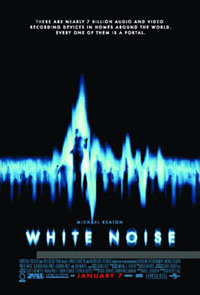 WHITE NOISE
WHITE NOISE(PG-13)
** (out of 5)
January 7, 2005
STARRING
Michael Keaton as JONATHAN RIVERS
Chandra West as ANNA RIVERS
Deborah Kara Unger as SARAH TATE
Ian McNeice as RAYMOND PRICE
Sarah Strange as JANE
Nicholas Elia as MIKE RIVERS
Studio: Universal
Directed by: Geoffrey Sax
BY KEVIN CARR
Listen to Kevin’s radio review…
Contrary to what the art-house industry would have you believe, making a horror movie is one of the most challenging things to do in cinema. Sure, crappy horror movies are a dime a dozen because horror is safe. Even a bad, schlocky horror movie can be good in a campy way. Heck, this is the entire basis of franchises like “A Nightmare on Elm Street” and “Friday the 13th.”
But the real challenge for a horror movie is to do a serious one – to do one that, if it stinks, it will stink forever. In this light, I have a modicum of respect for the folks that bring you “White Noise.” I have to give them credit. They were trying to do something serious. Unfortunately, while serious horror worked in films like “The Ring” and “The Sixth Sense,” it falls flat here.
“White Noise” follows the grief of Jonathan Rivers (Michael Keaton), who recently suffered the death of his young wife (Chandra West). Shortly after, Jonathan started to receive message from the other side, buried in electromagnetic signals. This phenomenon, known as EVP (Electronic Voice Phenomena), has been documented since the 1920s and is a process by which some believe the dead can communicate with the living. At first, Jonathan is not sold on the concept, but as time goes on he becomes a believer. However, as he starts experimenting in the realm and trying to interpret messages himself, he starts to uncover the darker side of the phenomenon.
Visually, “White Noise” is pretty compelling. However, it does suffer from some over-production. There’s a lot of breathing in this film, and lots of shots of Michael Keaton with his ear to a static-producing speaker. I could have done with fewer shots of Keaton’s ear – a lot fewer shots.
As a whole, the film doesn’t fit together. It’s actually three different types of movies ground together into hamburger and splattered on the screen. The opening is meant to be ominous by presenting picture-perfect settings with an eerie soundtrack. But I just didn’t buy any of this because I knew the wife was toast from the beginning. Add to the fact that they added an unimportant side plot that she was pregnant as well. Heck, knowing that, when I saw her drive off, I was just counting the moments for her to turn up missing.
The middle is probably the most intriguing part. Here, Jonathan is learning more and more about EVP himself. There’s a bit of a mystery for him to solve, and things actually pick up. The unfortunate thing about a film like this is that the layout of a mystery can be pretty easy to set up. The payoff always tends to be a problem.
And the payoff was a problem. It really made no sense. Without resulting to spoilers, I’ll just say that there is a reason behind all this, but it only seems to make sense to the writer. If you think too long about it, you’ll just get a headache.
Last year, one of the most effective horror movies to hit the theater was “The Grudge.” And after seeing “White Noise,” I realized what helped make “The Grudge” so effective.
In this age of computer wizardry, digital effects are too easy to do. You see them everywhere, bringing the industry to the point that they are so commonplace they are no longer cool. What was great about “The Grudge” is that they showed the ghosts from scene one. And they didn’t hide things. The ghosts were right there in your face. It was a real ballsy move.
But here in “White Noise,” they tried to hide the ghosts, only revealing them in flash frames and quick glimpses. It’s an effective set-up, but you’d better have one heck of a shocker at the end. When we have the final reveal in “White Noise,” the ghosts were laughable at best and downright lame and boring at worst. This is because there was no creativity to them. It was just some CGI animator throwing together a standard look for ghosts. Even the guttural shadow men from 1990’s “Ghost” were scarier.
“White Noise” stands on a great concept, but the creativity behind it just didn’t have the backbone – or the vision – to make it work.
Podcast: Play in new window | Download
